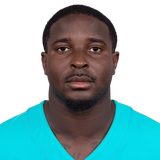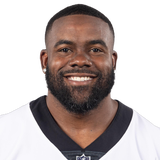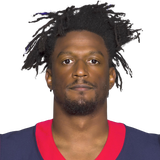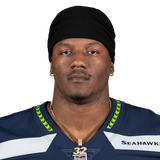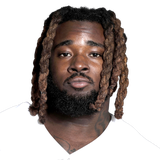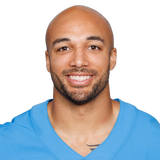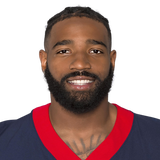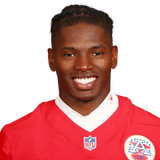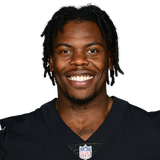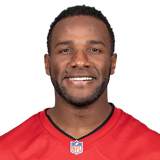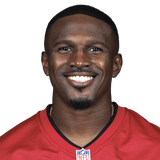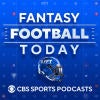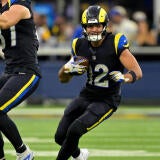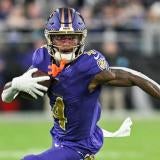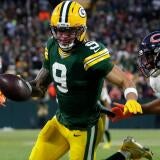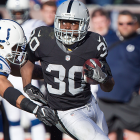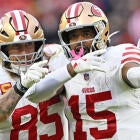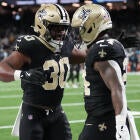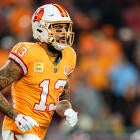Some expect Henry to add receptions in 2019, but he has a long way to go before that becomes a strength. And while he looks like the primary red zone back for the Titans, a below average offense holds him back. Of 48 backs with 100 Fantasy points in 2018, Henry's 83.9% TRAP was seventh-lowest. David Johnson scored more than 40% of the Cardinals' offensive touchdowns last year, and still finished with just 10. Tennessee's offense likely won't be that bad, but Henry will have to thread a needle of elite rushing production and a similarly high share of touchdowns to be an RB1 in 2019.
| ||||||||||||
Another back with limited passing-game usage, Michel at least plays in a good offense. The problem is that in five of the past six seasons, no New England back has rushed for more than seven touchdowns, with the notable exception being LeGarrette Blount's 18 in 2016. You can chase that scoring upside, or you can recognize the Patriots' willingness to hurry up to the goal-line without substituting as well as the presence of rookie third-round pick Damien Harris make it unlikely Michel dominates scoring chances in this iteration of the offense.
| ||||||||||||
No team in the league has as many combined running back touchdowns in any of the past three seasons as the Saints averaged over that span. And no other team can lay claim to being in the top five of targets to the position in every season for over a decade. Leaving an offense like that and joining one with a quarterback who likes to improvise will greatly reduce both Ingram's scoring and reception upside. Baltimore's presumed lead back has also been usurped each of the past three seasons, and their depth chart is deep at the position in 2019.
| ||||||||||||
Miller looked like a safe bet to turn a profit at his depressed ADP before the Duke Johnson trade and still may, but what's the point? We know what 16 games of him in this offense looks like, and it's not going to win you your league. You also won't lose it by missing out on that. Miller is the type of pick you make to feel secure about your depth on Draft Day, but doesn't actually move the needle and instead takes a roster spot from another shot at a true difference-maker. Save the pick.
| ||||||||||||
While his rush attempts more than doubled as the lead back in his second season, Mack's targets and receptions somehow dropped last year relative to his part-time rookie season. That's not a good sign, especially since it can be linked to last year's rookie Nyheim Hines. With Parris Campbell also now in the fold to eat up short-area targets, drafting Mack equates to buying his rushing efficiency bump from 2018, when he rushed for 908 yards and nine scores in just 12 games. Problem is, even with strong rushing efficiency, he was just RB14 in points per game.
| ||||||||||||
Mike Davis' 42 targets in 2018 led Seattle backs, and were more than Carson and Rashaad Penny combined. So there's some work available on passing downs, and Penny's TRAP was even worse at 88.3%. But Penny's sample is a lot smaller, and Carson's injury-shortened 2017 does back up his touch mix. I'm projecting Penny as more likely to gain the available receiving work than Carson (not to be overlooked here, it could be a third back again), and thus am limiting exposure to Carson.
| ||||||||||||
Fantasy Football Draft Prep: TRAP backs to avoid, plus 11 late-round upside targets
Ben Gretch applies his new metric TRAP and his look at the Running Back Dead Zone to identify eight backs to avoid in high-leverage rounds and 11 later-round upside targets.
I've been doing a lot of philosophizing about running backs lately. On Tuesday, I broke down how to target the right kind of running back for Fantasy success and introduced a stat called TRAP to help you accomplish that. On Wednesday, I explained what "The Running Dead Zone" is and why you should fade running backs in specific high-leverage rounds.
Now we get to the fun stuff. Let's combine the two and name specific Dead Zone backs to avoid and late-round upside targets, using TRAP and everything else we know about the running back position.
Dead Zone Backs To Avoid
TRAP stands for Trivial Rush Attempt Percentage, and measures a player's percentage of total touches that are low-value rush attempts outside the 10-yard line. In other words, players with a high TRAP don't catch enough passes or get enough scoring chances, which are the two biggest ways running backs to display elite Fantasy upside. The league average TRAP across the past five seasons is 75.1%.
If you just can't wait to build out your running back depth chart until the later rounds, here are a few TRAP backs to stay far away from.
8 to avoid, 11 to target
Two more to consider: Nick Chubb (TRAP: 82.0%), Aaron Jones (TRAP: 78.6%)
Chubb and Jones are difficult because both are backs I'm not explicitly avoiding, but their TRAPs say maybe I should be. Chubb's receiving appears impacted by Duke Johnson early and Kareem Hunt later, and while he could be in line for an increase in green-zone touches as this offense improves, a lack of receiving would limit his ceiling. Jones would seem to have less in the way of improving his receptions total from 2018, but Jamaal Williams has often gotten praise for his pass-blocking, and still out-targeted Jones last season.
Late-round upside targets
If any of the below names were surer bets, their ADPs would rise. But a shotgun approach that lands four or five backs like this in every draft is the best chance to increase your chances to hit the jackpot.
Jones hardly touched the ball in 2018, so his 2018 TRAP isn't particularly notable. But presumed starter Peyton Barber's 83.1% is. Last year, Barber became the first 250-touch back since 2013 to fail to reach 1,000 total yards. And the Buccaneers didn't draft a running back or make a notable signing, something that should indicate they still believe in their second-round pick from a year ago, especially considering Jones was the youngest back in last year's draft. Jones isn't exactly a late-round target, and it remains to be seen whether adding some bulk this offseason will limit his speed, but his awful rookie season has kept his ADP in a range that makes him worth a shot now that Bruce Arians is in town. The potential for a second-year breakout is apparent.
| ||||||||||||
We don't know Melvin Gordon's status, and that's rightfully causing Ekeler's ADP to rise. But even if Gordon were on the field, Ekeler would be a target. Gordon hasn't always been the healthiest back, and Ekeler's track record of receiving production and the Chargers' heavy use of running backs in the green zone give him both standalone value and upside.
| ||||||||||||
Much like Ekeler, Samuels is a presumed No. 2 with a track record of receiving production in an offense that has supported recent RB1 seasons. Samuels may not get the lion's share of the backfield work if something were to happen to James Conner, but he'd certainly be in line for a touch boost, and his receiving profile suggests he'd be the more Fantasy-valuable back in a potential split with Benny Snell.
| ||||||||||||
Damien Williams' elite TRAP makes him a target of mine in the early rounds, but the risks are apparent, and a recent hamstring issue makes him even more of a concern. Of the backups, I prefer Thompson, as his receiving production at Utah State indicates the dual-threat skill set Andy Reid loves. Carlos Hyde, on the other hand, had the third-highest TRAP in 2018 (85.7%) and has a career yards per target more than 50% below league average. Reid could likely improve Hyde's receiving efficiency, but for now I'm siding with the back I think profiles better in this offense, and that's Thompson.
| ||||||||||||
No back who scored at least 100 Fantasy points in 2018 had a lower TRAP than Richard, who may not have elite upside even if something were to happen to Josh Jacobs, but whose receiving profile is overlooked as he languishes deep in the double-digit rounds of drafts. And even that lack of upside may be overstated -- if Jacobs misses time, it's entirely possible Richard would stay on the field for a larger workload over Doug Martin or the other backs on Oakland's depth chart.
| ||||||||||||
If Henry is one of my biggest fades, it's hard not to understand Lewis's inclusion here. A big free agent signing one year ago, Lewis was plenty involved in his first season in Nashville. Henry's late-season boom has drafters salivating about 2019, while Lewis is an easy value late in drafts as a player with a better touch mix with a decent history of lead back production that could be a big hit if Henry were to miss time.
| ||||||||||||
Smith was inefficient in his rookie season, but his touch mix and the departure of Tevin Coleman portend potential upside in Year 2. Devonta Freeman is not the picture of health, and Smith appears likely to work in and have some standalone value even if Freeman can stay upright all season.
| ||||||||||||
Johnson's TRAP is great, but it's not clear what his role will be now that he's with the Texans. That said, playing behind/alongside Lamar Miller is a better situation than what he had in Cleveland, he looks like a strong weekly play if Miller ends up missing any time.
| ||||||||||||
The addition of Parris Campbell muddies Hines' receiving projection, as he may not get as many opportunities to split out of the backfield. That said, Hines' ADP is at a point where his combination of a receiving profile in a high-scoring offense makes him a clear value.
| ||||||||||||
Continuing this thread of receiving backs behind presumed workhorses, Bernard is another easy value, and one who would likely get the early-down work if Joe Mixon were to miss time. Much has been made of the Bengals' decision to draft two sixth-round running backs, but after Mark Walton's disastrous first season with the team, it was clear they needed depth. And one of those picks, Rodney Anderson, appears likely to begin the season on the PUP list. It's unclear why these picks would turn drafters off Bernard, who has always risen to larger workloads and was very productive when Mixon missed time early in 2018.
| ||||||||||||
Edmonds represents another backup to a workhorse starter with a strong touch mix (albeit in a limited sample, but he projects as that type of player) in a potentially plus Fantasy offense. It's hard to fathom how he goes undrafted in many leagues.
| ||||||||||||
That's it for now. Play around with the TRAP leaderboard and follow these guidelines to build dominant rosters in 2019.
So what 2019 Fantasy Football breakouts should you target in your draft? And which rookie running back is a must-have RB2? Visit SportsLine now to get 2019 Fantasy Football cheat sheets from the model that called Tevin Coleman's breakout season, and find out.



